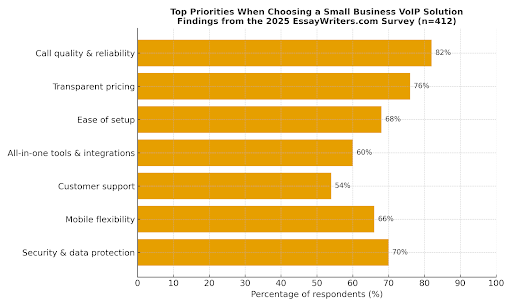When Michael Perkins began his latest study, he expected the usual numbers: latency scores, support wait times, setup speeds. What he didn’t expect was how emotional people felt about their phones.
The research team of essay writers behind him soon discovered that for many small business owners, a small business VoIP solution wasn’t just a tech upgrade. It was how they stayed connected to clients, managed remote teams, and kept their day moving.
How the Study Was Done?
The research team gathered input from 412 participants across two audiences:
- small business owners running operations with fewer than 20 employees;
- student founders juggling side projects or online startups.
Each participant rated what mattered most in their communication system. Perkins didn’t stop there. He ran time trials for setup, measured call quality, and compared support response times. It gave him a complete view of what people say versus what they experience.
He found that one in three users had already switched VoIP providers in the past year. Their top reasons: poor call quality, confusing bills, and missing mobile features. The team turned that data into a ranked list of what users really value.
What Users Value the Most?
Users in the study shared consistent priorities that shaped their satisfaction.

i. Reliable, Clear Calls
Over 80% said this mattered above all. A crackling line instantly broke trust during a sales pitch or client call. Perkins noted that users rated reliability as the one thing worth paying extra for.
ii. Simple Pricing
Participants were clear: no hidden fees. They wanted monthly plans that match usage. Small teams especially disliked minute-based billing.
iii. Fast, Easy Setup
Student founders stood out here. They could launch a VoIP small business solution within an hour on average. Small firms took longer but wanted better guides to shorten the process.
iv. Integrations that Reduce Multitasking
Sixty percent used VoIP tools linked with their calendar or CRM. Users preferred systems that worked in the background, keeping calls and data in sync without more tabs.
v. Support that Feels Human
When something broke, users wanted answers fast. Many said that even a friendly tone from support made them stay with the same provider longer.
vi. Mobile Flexibility
Two-thirds of respondents said they worked from home or on the move. They valued apps that worked smoothly on laptops and phones.
vii. Security that Feels Effortless
Around 70% asked about encryption and data safety. They didn’t want complicated explanations – just confidence that their calls were protected.
These points became the foundation for Perkins’ deeper benchmarks, comparing how well different systems met these expectations.
What the Data Adds Up To?
Perkins’ data showed small but telling differences between user groups. Students cared about cost first, while entrepreneurs looked for performance and scalability. Both wanted freedom from constant tech fixes.

Students described their ideal VoIP phone solution for small business as “a personal assistant that never messes up.” Entrepreneurs called for better analytics, like call durations and missed-call alerts, so they could plan staffing more efficiently.
A Closer Look at the Value Matrix
Perkins organized his findings into what he calls a “Value Matrix” – a way to compare core product types by their strongest and weakest traits. The goal is to help teams see which model fits their size, pace, and comfort level.
| Type of platform (Perkins benchmark) | Setup time | Ease of use | Cost predictability | Feature breadth | Support quality |
| Unified Suite (voice, video, chat) | Moderate | High | Medium | Broad | Strong |
| Budget Starter Plan | Fast | Very high | Very high | Limited | Moderate |
| Scalable Business Platform | Moderate | Moderate | High | Extensive | Strong |
| AI-Driven VoIP Environment | Slow | Moderate | Medium | Advanced | Moderate |
| Mobile-First Cloud Solution | Very fast | Very high | High | Moderate | Strong |
Teams starting out tend to favor quick setup and affordability, while mature companies focus on deeper features.
Perkins also noted rising interest in small business VoIP solutions Zoom phone types that merge calls and meetings in one app. He predicts this model will dominate hybrid work environments within two years.
Insights That Didn’t Fit the Graphs
Some of the richest findings came from user comments rather than numbers.
- Bandwidth makes or breaks quality. Offices sharing weak Wi-Fi suffered most call issues.
- Training matters. Only one in four users had training on advanced VoIP features.
- Clutter fatigue is real. Users said they ignored half of the buttons on their dashboards.
- Switching fear persists. A quarter stayed with outdated systems because they worried about downtime during migration.
Perkins summarized it simply: “Most problems aren’t about bad software. They’re about bad onboarding.”
New Trends Worth Watching
Beyond the main priorities, the study uncovered growing curiosity about AI in VoIP. Nearly a third of respondents wanted automatic transcripts or smart note-taking during calls. Still, few saw those as essential – yet.
Another finding surprised even Perkins. Users mentioned sustainability. They preferred cloud-based setups that use fewer physical phones and cables. This small but clear shift hints at how future customers will evaluate tech purchases.
In his report, Perkins explained that the next wave of VoIP innovation will center on smarter summaries and lower environmental impact.
Practical Advice Before You Choose
To help readers apply the research, Perkins outlined a few habits shared by the most satisfied users.
Before you sign a contract, test your provider on real calls across networks. Check response time from support – send a question before you buy. Compare total yearly cost, not just the first month. And if the business small solution VoIP platform offers a free trial, use it to gauge how your team handles setup.
He also reminded users to keep security simple. If you can’t explain how your call data is protected, you probably don’t have full control.
Looking Ahead: The Next Wave of Communication
The VoIP market is changing faster than most small businesses can keep up with. Perkins expects steady growth as landline networks fade out. By 2026, cloud voice tools will likely be as standard as email.
He believes the best small business VoIP solution will combine three things: strong sound quality, transparent billing, and mobile-first design. “People don’t need another dashboard,” he said in his final notes. “They need conversations that work every time.”
To stay aligned with evolving needs, the analytics group plans to repeat this survey yearly, tracking how features like AI transcription, advanced routing, and smart summaries gain traction among students and small teams alike.
Takeaway from Michael Perkins
The best tech fades into the background – it doesn’t demand attention. Whether it’s a student startup pitching investors or a small bakery calling suppliers, success depends on something simple: people hearing each other clearly and without delay.
His advice to teams still shopping for VoIP tools is to start small, learn fast, and upgrade when ready. Communication doesn’t need to be fancy. It needs to stay reliable and leave room for the next big idea.
Read More : Cloud Phone System : A Complete Business Communication Guide


